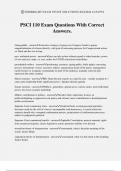©THEBRIGHT EXAM STUDY SOLUTIONS 8/22/2024 12:54 PM
PSCI 110 Exam Questions With Correct
Answers.
Going public - answer✔✔executive strategy of going over Congress' heads to garner
support/attention of citizens directly, with goal of increasing pressure for Congressional action,
ex. Bush and the war in Iraq
pres. unilateral power - answer✔✔pres can take action without regard to other branches, power
of veto and exec order, ex. exec orders for COVID restrictions from Biden
presidential toolbox - answer✔✔positioning, resources (going public, bully pulpit, convening
power), instruments (vetoes, executive orders), organization (head of the party), management
(staffs fed gov't), weaponry (commander in chief of the military), mandate (only the pres
represents the entire country)
House structure - answer✔✔BIG- Reps become experts in a specific area - usually assigned to 1
cmte, party leadership holds significant power - Speaker decides agenda
Senate structure - answer✔✔SMALL- generalists, spread across various cmtes, more individual
power, less focus on party leadership
Media's contribution to politics - answer✔✔Decides what's important, focuses on
politics/infighting as opposed to real policy and citizens' need, contributions to hostile/partisan
politic environment
Supreme Court countermaj. fears - answer✔✔Unelected body second-guessing legislative
decisions made by the will of voters is incompatible with democracy, a system where the
majority should rule, corrupted confirmation process, polarization of confirmation processes
makes its judgements political
Supreme Court countermaj benefits - answer✔✔upholds Constitution, protects minority rights
from tyrannical majority, checks legislative action, promotes stability over discord
textualism theory of interpretation - answer✔✔constrained, what is the plain meaning of the
words, Justice Black
originalism theory of interpretation - answer✔✔constrained, what was the intent at the founding,
Justice Scalia
, ©THEBRIGHT EXAM STUDY SOLUTIONS 8/22/2024 12:54 PM
moralism theory of interpretation - answer✔✔flexible, what are the core ideological
commitments created by the Constitution, ie. ideal of human dignity, Justice Brennan
wholism/structuralism theory of interpretation - answer✔✔flexible, what is the goal of the
Constitution, what makes sense to allow the overarching apparatus to work, Justice Breyer
When Supreme Court is most powerful - answer✔✔When it realizes it is a political institution
and never lags too far behind or is too far ahead, models itself off of the public's changing
perceptions of the Constitution
Factors that allowed ACA to pass - answer✔✔Trifecta of united Dem. gov't,
support/neutralization of key interest groups, party solidarity among Dems as a result of razor-
thin majority, convergence on a single policy proposal, increasing and publicly salient policy
inadequacies
Factors that have prevented immigration reform - answer✔✔main impacted ppl not able to vote,
intra and interparty disagreement on what the issue is, Ascriptive Americanism
modern day change in social movements - answer✔✔becoming more professionalized and
money over time based -> disregards needs of ppl who actually require help, ex. organized and
professional BLM has not done much to help families of victims
powers of special interest groups - answer✔✔inform public on topic, contribute to/endorse
campaigns, influence legislation directly
Role of political consultants - answer✔✔strategy/cohesiveness of the campaign and also basic
management, increasing cruciality means increasingly expensive campaigns, increasing focus on
financially significant groups
Negative campaign advertising fears - answer✔✔Appeals only to partisans who have already
made up their minds, dissuades moderates from voting -> increases polarization
Negative campaign advertising benefits - answer✔✔"multivitamins" of democracy; provides
useful info, heightens interests, and raises/sharpens stakes -> actually mobilizes voters, ex.
George W. Bush's infantilizing ad against Kerry made him seem rich and out of touch with
America
Federalism - answer✔✔different levels of government sharing power
Dual federalism - answer✔✔founding -> mid 1800's, fed and state gov'ts stay in separate spheres
Cooperative federalism - answer✔✔mid 1800's -> New Deal, fed gov't gives states money to do
things in the interests of both, ex. public universities, canals/bridges
Coercive/fiscal federalism - answer✔✔fed gov't gives states money but with very specific strings
attached, ex. fed highway funding and 21 drinking age, origins of Social Security




